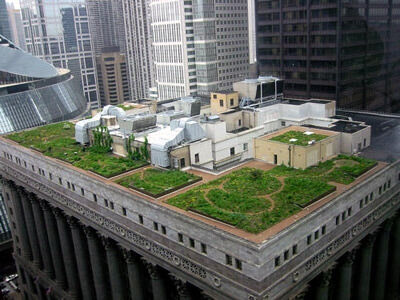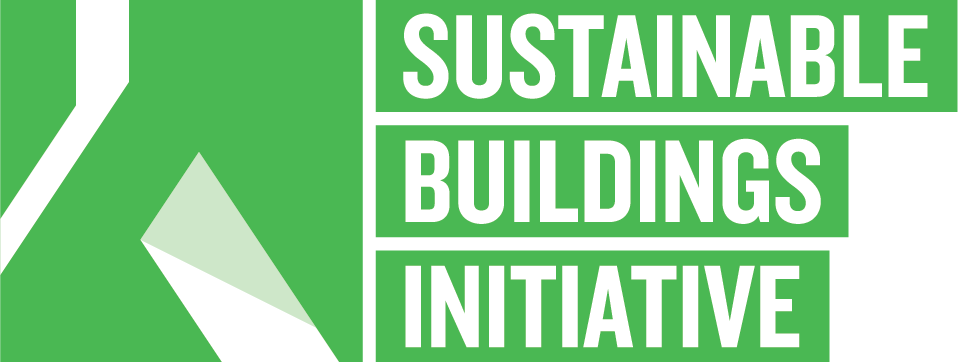Office Design
Opt for a Green Roof
What Is It?

Katrin Scholz-Barth
Green roofs consist of a vegetative layer grown on part or most of a rooftop. They can shade the roof surface, help to remove heat in the air, and support stormwater management.
Whereas conventional rooftops absorb heat and can be up to 90 degrees hotter than ambient air temperature, green rooftops can remain cooler than the surrounding air and reduce building cooling costs. Widespread use of green roofs in urban environments can reduce the urban heat island effect: a study of Toronto suggested that use of green roofs on 50% of rooftop surfaces in downtown could lead to cooling the entire city by up to 1.4⁰F. In winter, green roofing provides an insulating effect, reducing building heat loss and heating costs.
Green roofs can also enhance stormwater management, capturing over 50% of rainfall and reducing runoff to storm drains. Careful selection of vegetation can allow green roofs to also capture pollutants from stormwater, including phosphorous, nitrogen, and heavy metals. Green roofs can reduce temperature variations and ultra-violet ray exposure on roofing materials, potentially extending the roof’s life by 40-60 ears.
There are two main types of green roofs. Intensive green roofs are over 6” deep and allow for a wide range of vegetation to be grown on the roof, including shrubs and potentially trees. Intensive green roofs can provide social and recreational uses, but are typically more costly to install and require more regular maintenance and potentially, irrigation. They can only be installed on flat rooftops that can support the additional weight, potentially limiting their application in retrofits.
Extensive green roofs are shallower, lighter weight systems that typically have lower upfront and maintenance costs than intensive green roofs. Extensive green roofs have been successfully grown on roofs with slopes of greater than 30⁰, and tend to be more cost-effective in retrofits.
Green-blue roofs (e.g. PolderRoof) are intensive green roofs that store rainwater and support stormwater management. The rainwater helps irrigate the plants and control units can help facilitate the system’s operation.
Benefits
- Reduces building heating and cooling costs. In summer, green roofs reduce building and ambient air temperatures. In winter, green roofs reduce building heat loss.
- Enhanced urban stormwater and pollutant management.
- Reduced sound transmission and reflection.
- Prevents UV and ozone damage to waterproofing systems.
- Can be used for gardening to save on food costs.
- Ecological benefits include safe habitats for birds and insects, potentially including endangered species.
- Improved air quality, carbon sequestration, and building aesthetics.
Drawbacks
- Green roofs (particularly intensive green roofs and green-blue roofs) add additional weight to the building roof. Additional structural reinforcement may be necessary for installation.
- Green roofs require extensive rooftop waterproofing, as water becomes retained on the roof during storms. Roots may penetrate waterproof membranes, leading to structural damage.
- Higher upfront costs than traditional roofing.
- Most systems cannot be placed on sloped or curved roofs.
Regulatory Impacts and Requirements
Potential regulatory touchpoints in Boston and Massachusetts include:
- Fire Department
- Building Code/Permit
Note: Article 89 of the Zoning Code authorizes urban farming on the ground and roof level – both in open air and in a greenhouse.
Financing Options, Incentives, and Rebates
NEWS
- "Living Roofs Reduce Stormwater Runoff" Inside Science, August 15, 2013
- “Boston Properties’ Atlantic Wharf: A Case Study,” National Real Estate Investor Online, June 7, 2013
- “Chicago’s Battle of the Roofs: Green vs. White,” Governing.com, December 2012
RESOURCES
- State of Massachusetts: Green Roof Planning Study for the City of Boston
- Massachusetts DEP: Green Roofs and Storm Water Management
- U.S. EPA: Using Green Roofs to Reduce Heat Islands
- Metropolitan Area Planning Council: Low-Impact Development Toolkit
- Metropolitan Area Planning Council: Green Roof Fact Sheet
PROJECT EXAMPLES
- Boston Properties’ Atlantic Wharf – Boston, MA
- Boston University Student Services Center – Boston, MA
- Harvard University Business School Shad Hall – Cambridge, MA
- 601 Congress – Boston, MA
- MIT Stata Center – Cambridge, MA
- Fenway Farms – Boston, MA
- Watermark Residences – Boston, MA
A SAMPLE OF PROVIDERS
- HydroTechUSA GardenRoof: Extensive, Intensive, Sloped, Grass
- Recover Green Roofs
- LiveRoof: Lite, Standard, Deep Maxx
- CertainTeed: installs LiveRoof products
- Apex Green Roofs
- Polder Roofs: Green-Blue Roofs


